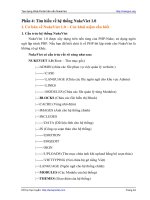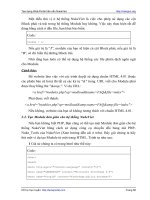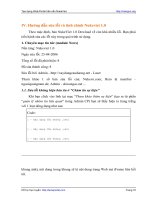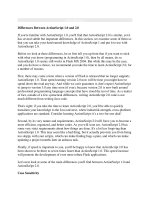Wyckoff 2.0 structures, volume profile and oder flow Rubén Villahermosa
Bạn đang xem bản rút gọn của tài liệu. Xem và tải ngay bản đầy đủ của tài liệu tại đây (26.36 MB, 342 trang )
Wyckoff 2.0: Structures, Volume
Profile and Order Flow
Combining the logic of the Wyckoff
Methodology and the objectivity of the
Volume Profile
Rubén Villahermosa Chaves
Liên hệ zalo: 0898424904 để được hỗ trợ tải nhanh nhất
Copyright © 2021 Rubén Villahermosa Chaves
All rights reserved
No part of this book may be reproduced, stored in a retrieval system, or
transmitted in any form or by any means, electronic, or by photocopying,
recording, or otherwise, without the express permission of the publisher.
Liên hệ zalo: 0898424904 để được hỗ trợ tải nhanh nhất
Content
PROLOGUE
PART 1. ADVANCED CONCEPTS OF THE WYCKOFF
METHODOLOGY
1.1 THE LABELS
1.2 PRICE & VOLUME
1.3 ADVANCED CHART TYPES
1.3.1 TICK CHARTS
1.3.2 VOLUME CHARTS
1.3.3 RANGE CHARTS
1.4 ACCUMULATION OR DISTRIBUTION FAILURE
1.5 STRUCTURAL FAILURE
Liên hệ zalo: 0898424904 để được hỗ trợ tải nhanh nhất
1.5.1 WEAKNESS
1.5.2 STRENGTH
1.6 SHORTENING OF THE THRUST (SOT)
1.7 OTHER TYPES OF STRUCTURES
1.7.1 STRUCTURES WITH A SLOPE
1.7.2 UNUSUAL SCHEMES
PART 2. RESOLUTION OF FREQUENT DOUBTS
2.1 EFFICIENT USE OF LINES
2.1.1 THE IMPORTANCE OF CONTEXT
2.2 LABEL CHANGES AND SCENARIO PLANNING
2.3 HOW DO YOU DISTINGUISH BETWEEN ACCUMULATION
AND DISTRIBUTION?
2.4 HOW TO ANALYZE A CHART FROM 0?
Liên hệ zalo: 0898424904 để được hỗ trợ tải nhanh nhất
2.4.1 STRUCTURES
2.4.2 OPERATIONAL ZONES
2.4.3 DECREASE IN TEMPORALITY. STRUCTURES FROM MAJOR
TO MINOR
2.4.4 INCREASE IN TEMPORALITY. STRUCTURES FROM MINOR
TO MAJOR
2.5 WHAT TO DO WHEN THE CONTEXT IS NOT CLEAR?
2.5.1 THE CONTROLLER
PART 3. THE CURRENT TRADING ECOSYSTEM
3.1 TYPES OF PARTICIPANTS IN THE FINANCIAL MARKETS
3.2 ELECTRONIC MARKETS
3.2.1 ALGORITHMIC TRADING
3.2.2 HIGH FREQUENCY TRADING
Liên hệ zalo: 0898424904 để được hỗ trợ tải nhanh nhất
3.3 OVER THE COUNTER MARKETS
3.4 DARK POOLS
3.5 ARE MARKETS RANDOM OR DETERMINISTIC?
3.5.1 THE ADAPTIVE MARKET HYPOTHESIS
3.5.2 WHERE DOES THE WYCKOFF METHODOLOGY FIT IN?
PART 4. THE IMPORTANCE OF VOLUME
4.1 AUCTION MARKET THEORY
4.1.1 THE VARIABLES
4.1.2 VALUE PERCEPTION
4.1.3 THE FOUR STEPS OF MARKET ACTIVITY
4.2 THE LAW OF SUPPLY AND DEMAND
4.2.1 COMMON INTERPRETATION ERRORS
Liên hệ zalo: 0898424904 để được hỗ trợ tải nhanh nhất
4.2.2 BID/ASK, SPREAD AND LIQUIDITY
4.2.3 TYPES OF PARTICIPANTS BASED ON THEIR BEHAVIOR
4.2.4 HOW DOES THE PRICE MOVE?
4.2.5 HOW DO MARKET TURNS OCCUR?
4.3 ORDER TYPES
4.3.1 ADVANCED ORDER TYPES
4.4 TOOLS FOR VOLUME ANALYSIS
4.4.1 ORDER BOOK
4.4.2 TIME & SELLS
4.4.3 FOOTPRINT
4.4.4 DELTA
4.5 THE ORDER FLOW PROBLEM
Liên hệ zalo: 0898424904 để được hỗ trợ tải nhanh nhất
4.5.1 PROBLEM #1 PRICE DIVERGENCE
4.5.2 PROBLEM #2 DELTA DIVERGENCE
4.5.3 PRICE & VOLUME OPERATOR
4.5.4 CONCLUSION
PART 5. VOLUME PROFILE
5.1 AUCTION MARKET THEORY + VOLUME PROFILE
5.2 VOLUME PROFILE COMPOSITION
5.3 PROFILE TYPES
5.4 DIFFERENCE BETWEEN VERTICAL AND HORIZONTAL
VOLUME
5.5 DIFFERENCE BETWEEN VOLUME PROFILE AND MARKET
PROFILE
5.6 PROFILE SHAPES
Liên hệ zalo: 0898424904 để được hỗ trợ tải nhanh nhất
5.6.1 P-SHAPE PROFILE
5.6.2 B-SHAPE PROFILE
5.7 VOLUME PROFILE USES
5.7.1 STRUCTURE IDENTIFICATION
5.7.2 DETERMINING MARKET BIAS
5.7.3 TREND HEALTH ANALYSIS
5.7.4 VPOC MIGRATION
5.7.5 CALIBRATION OF POSITION MANAGEMENT
5.8 OPERATIVE PRINCIPLES WITH VALUE ÁREAS
5.8.1 TRADING RANGE PRINCIPLE
5.8.2 REVERSION PRINCIPLE
5.8.3 CONTINUATION PRINCIPLE
5.8.4 FAILED REVERSION PRINCIPLE
5.8.5 SUMMARY TABLE OF OPERATING PRINCIPLES WITH
VALUE ÁREAS
PART 6. ORDER FLOW
6.1 READING THE FOOTPRINT
6.2 IMBALANCES
6.3 ROTATION PATTERN
6.3.1 BEARISH ROTATION PATTERN: BUYING ABSORPTION
AND INITIATIVE SELLING
6.3.2 BULLISH ROTATION PATTERN: SELLING ABSORPTION
AND INITIATIVE BUYING
6.4 CONTINUATION PATTERN
6.5 FRACTALITY
PART 7. WYCKOFF 2.0
7.1 CONTEXT ANALYSIS
7.1.1 TRADING RANGE CONTEXT
7.1.2 TREND CONTEXT
7.1.3 OPERATING IN TRADING RANGE
7.1.4 OPERATING IN TREND
7.2 IDENTIFICATION OF ZONES AND OPERATIONAL LEVELS
7.3 SETTING UP SCENARIOS
7.4 POSITION MANAGEMENT
7.4.1 ENTRY
7.4.2 STOP LOSS
7.4.3 TAKE PROFIT
7.4.4 WHAT TO DO WHEN THE PRICE LEAVES WITHOUT US?
PART 8. CASE STUDIES
8.1 EURO/DOLLAR CROSS CURRENCY ($6E)
8.2 POUND/DOLLAR CROSS CURRENCY ($6B)
8.3 S&P500 INDEX ($ES)
8.4 US DOLLAR/CANADIAN DOLLAR CROSS CURRENCY ($6C)
8.5 POUND/DOLLAR CROSS CURRENCY ($6B)
8.6 EURO/DOLLAR CROSS CURRENCY ($6E)
BIBLIOGRAPHY
ACKNOWLEDGEMENTS
ABOUT THE AUTHOR
BOOKS OF THIS AUTHOR
Prologue
With the publication of this new content we give continuity to the first book
"The Wyckoff Methodology in Depth", where all the analytical tools that this
methodology covers are presented in a clear way, as well as the more
theoretical aspect in the study of the behavior of financial markets.
In this book we will go a step further and discuss more complex concepts;
we will review the doubts most commonly raised by students of the
methodology and incorporate new tools based on the information provided
by the volume data that will be very useful, such as the Volume Profile and
Order Flow.
I strongly recommend that before starting the study of this book you have
previously internalized all the concepts covered in the first one, since
everything seen is taken as understood and, if not, it could cause some
confusion or lack of understanding.
Liên hệ zalo: 0898424904 để được hỗ trợ tải nhanh nhất
Part 1. Advanced concepts of the Wyckoff
methodology
Both the previous book "The Wyckoff Methodology in Depth" and this one
do not intend to divulge at any time the approach of the Wyckoff
methodology from its purest point of view. There may be Wyckoff operators
who do but we understand that today's markets have changed substantially
from those studied by Richard Wyckoff and it is our task to know how to
adapt to these changes.
But if there is one thing that is invariable and where the advantage of this
approach over others really lies, it is the principles on which his teachings
are based. Regardless of how markets and their operators have changed,
everything continues to be governed by the universal law of supply and
demand; and this is the cornerstone of the methodology.
This new way that I propose to analyze the markets has caused me some
discussion with known (purist) disseminators of the method. As I said, my
objective is not to teach the most primitive form of the methodology, but to
take the principles I consider valid and enhance them together with the
most modern tools of volume analysis.
In fact, I believe that spreading Richard Wyckoff's teachings as he shared
them is practically impossible. In the end, each one teaches his point of view
of the methodology together with the tools that give him more confidence;
and this does not mean that any one is above the rest. The important thing
is to obtain profitability from the market regardless of the approach used.
Having said that, I am sure that if Richard Wyckoff were alive today, he
would have taken care to evolve his own teachings by adapting them to new
markets. As he was at the time, he would still be a student of volume, and
this would have led him to delve deeper into tools such as the Volume
Profile and Order Flow.
And this is exactly what we have done and what I will present to you
throughout the book; bringing together the most solid principles of market
analysis with the most advanced tools of volume analysis.
But before we get to that point let's add some advanced concepts that you
should know and clarify a number of doubts that occur frequently.
1.1 The labels
The entire theoretical section seen in the first book is a necessary and
indispensable content to master this approach and truly understand how
the market moves, but the Wyckoff methodology, or my way of
understanding it, goes much further.
It is not simply a matter of labeling a chart almost robotically and that's it.
We've learned what's behind each event; how it's formed, how it's
represented on the chart, the psychology behind it, and so on. But as I say,
the method is much richer.
I mention this because, by the very nature of the market, it is practically
impossible for two completely equal structures to occur. Although it is true
that every day we see "book" diagrams, which are very genuinely adapted to
the classic examples, in most cases the market will develop less conventional
structures, where the identification of such events will be more complex.
It is therefore essential not to focus on the exact search for the events
(mainly the stop events that make up Phase A) and to stay with the fact that
what is really important is the action as a whole. That is, in many chartics we
will see that a trend movement stops and starts a lateralization process, but
we are not able to correctly identify those first 4 stop events. Maybe in view
of this, we discard the asset and we are missing a future operational
opportunity. This is a mistake. As I say, the important thing is not that we
are able to identify those 4 stop events, but that the market has objectively
stopped the trend movement. It may not identify the Climax, the Reaction
and the Test in a genuine way, but the objective is that the market has
stopped and has started a change of character (migration from trend to
lateral state).
As we see in the examples, although these structures do not look anything
like the classic ones already studied; if we open the chart and we find
ourselves in that point that I mark with the arrow, it is not unreasonable to
think that possibly below they have developed a process of accumulation. It
will be more or less difficult to identify the events of the methodology, but
the objective is that we see a level where the price has rejected on several
occasions (Creek) and that it has finally managed to break through and
position itself above. This is the key.
Surely if we force ourselves we can label each and every movement but I
repeat that this is not the important thing. What is important about the
methodology is the logic behind it: that for the price to go up there must
first be an accumulation; and for a distribution to go down. The way or
manner in which these processes develop should not be the determining
factor.
The level of open-mindedness required is very great. Some may even have
their heads blown off, but this is the reality. Fortunately we often see classic
structures but the continuous interaction between supply and demand
means that these processes can develop in infinite ways, and we have to be
prepared to see them as well.
Rather than thinking about labeling each and every price movement, let's
focus on trying to identify according to the fingerprints we observe who is
probably gaining market control based on the theory studied.
1.2 Price & Volume
In our way of conceiving the market analysis initially we do not value the
possibility of not taking into account any of these two data, price and
volume. But as you delve deeper into the ecosystem that surrounds the
financial world, you begin to see some pitfalls.
Without going too far, I have to say that in my view the price data are
certainly more relevant than the volume data. And I will now reason out this
statement on the basis of two elements.
On the one hand, the intraday volume that we can analyse on any asset can
be very misleading depending on the time of the session. For example, at
the opening of the S&P500 US session in its local time (ETH), we will always
see a large volume, much larger than that seen prior to that opening during
the regular time (RTH). And of course, all of the previous analysis will be
somewhat biased.
As we can see from the ES chart (SP500 future), the highest volatility and
therefore price shift occurs during the American session, with the lack of
participation during regular trading hours being very clear. It wouldn't make
much sense to analyze the overall price and volume action as it could lead to
confusion.
It is not that during regular hours we have identified a movement with lack
of interest (low volume); but that low volume is due to an absence of traders
at that time. The same would happen with other moments of the session,
such as at the mid-day stop or just before the start of the day's final stretch,
when there is also a significant increase in volume.
Once we know this, we have two ways to solve this situation:
If we want to continue operating in intraday time frames we
must necessarily analyze price and volume in comparative terms; on
the one hand that observed during local time and on the other hand
that seen during regular hours.
In addition, the best way to avoid confusion is to analyze the
daily chart. As this timing covers both sessions (ETH and RTH), there
is no need to distinguish between them for analysis. But of course,
this would already require a total change in trading style.
If there is one piece of information that already incorporates all the
information, it is the price. The price is the chartic representation of all the
orders already executed. We could be analyzing an asset at any time and the
price action would be faithfully reflected without having to be aware of the
time of the session and perform comparative analysis. This is the advantage
of price.
Although without volume we lose a large part of the available information,
the continuous interaction between supply and demand leaves its mark on
the price and this develops patterns that are certainly repetitive (not in form
but in substance).
Obviously I am not recommending trading without analyzing the volume
data, it is not necessary, I simply wanted to highlight the prevalence of price
over volume for our understanding and trading of the markets.
Later on we will see another drawback of the volume data due to the Over
The Counter (OTC) and Dark Pools markets.
1.3 Advanced chart types
In recent times, other forms of representation of market activity have also
appeared. Among these types of charts, tick, volume and range charts stand
out.
The main advantage of these charts is that they reduce the noise present in
the time charts. These three types of charts have the common feature that
they eliminate the time variable, which can be very useful precisely for
conditions such as those described above, where the market covers
different activity environments.
1.3.1 Tick charts
A tick represents a transaction, a negotiation between two parties.
Therefore, the tick chart will be updated (the current candlestick will be
closed and a new one will be opened) when a certain number of
transactions (ticks) have taken place.
The configuration of the chart (the number of ticks) will vary between
markets as the volatility is different from one market to another. That's why
you will have to make different tests until you find the most suitable one.
Generally the volume will be very similar in all the candlesticks generated,
but there will be subtle differences that can give us interesting information
since this type of chart measures activity in terms of transactions, but does
not take into account the volume or amount traded in those transactions.
In other words, a chart set at 1000 ticks will generate a new candlestick
when those 1000 ticks occur, but the amount traded in those thousand
transactions will differ. It may be that 1 or more contracts are traded in one
transaction.









